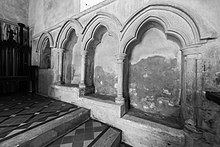Sedilia
In church architecture, sedilia (plural of Latin sedīle, "seat") are seats, usually made of stone, found on the liturgical south side of an altar, often in the chancel, for use during Mass for the officiating priest and his assistants, the deacon and sub-deacon. The seat is often set back into the main wall of the church itself.
Not all sedilia are stone; there is a timber one thought to be 15th century in St Nicholas' Church at Rodmersham in Kent.
When there is only one such seat, the singular form sedile is used, as for instance at St Mary's, Princes Risborough, Buckinghamshire or at St Agatha's, Coates, West Sussex.
The first examples in the catacombs were single inlays for the officiating priest. In time, the more usual number became three, although there are examples of up to five sedilia.[1]
The custom of recessing them in the thickness of the wall began about the end of the 12th century; some early examples consist only of stone benches, and there is one instance of a single seat or arm-chair in stone at Lenham in Kent.
The niches or recesses into which they are sunk are often richly decorated with canopies and subdivided with moulded shafts, pinnacles and tabernacle work; the seats are sometimes at different levels, the eastern being always the highest, and sometimes an additional niche is provided in which the piscina is placed.
Examples of Sedilia[]

Thirteenth-century Early English piscina and sedilia, St. Mary's, North Stoke, West Sussex

Twelfth-century sedile at Coates, West Sussex

Fifteenth-century piscina and sedilia, Lincluden Collegiate Church, Dumfries and Galloway
Sedilia at Ardfert Cathedral, Co. Kerry

A six-seater sedilia of c1200 in the Priory church of Deeping St James, Lincolnshire

Sedilia in the Canons' church, Klooster Ter Apel, Boslaan in Ter Apel, Netherlands

Gothic sedilia in the chancel of Kilfenora Cathedral, Co. Clare

Fourteenth-century sedilia at Heckington, Lincolnshire

Early twentieth-century sedilia, St Mellitus Church, Hanwell, London W7

15th-century Gothic sedile, St Mary's, Bletchingley

An ornately carved panel on sedilia at St. Willibrord's Church, Utrecht

Free-standing sedile or chair with desk in Alsike Kyrka, Knivsta, Sweden
References[]
- ^ Herbermann, Charles, ed. (1913). . Catholic Encyclopedia. New York: Robert Appleton Company.
This article incorporates text from a publication now in the public domain: Chisholm, Hugh, ed. (1911). "Sedilia". Encyclopædia Britannica. 24 (11th ed.). Cambridge University Press. p. 578.
Bibliography[]
| Wikimedia Commons has media related to Sedilia. |
- James Alexander Cameron, “From Hole-in-the-Wall to Heavenly Mansions: The Microarchitectural Development of Sedilia in Thirteenth-Century England”, in Jean-Marie Guillouët and Ambre Vilain (eds.), Microarchitectures médiévales. L'échelle à l'épreuve de la matière, Paris, INHA/Picard, 2018 (ISBN 978-2-7084-1042-8).
- Church architecture
- Church architecture stubs
- Architectural element stubs












